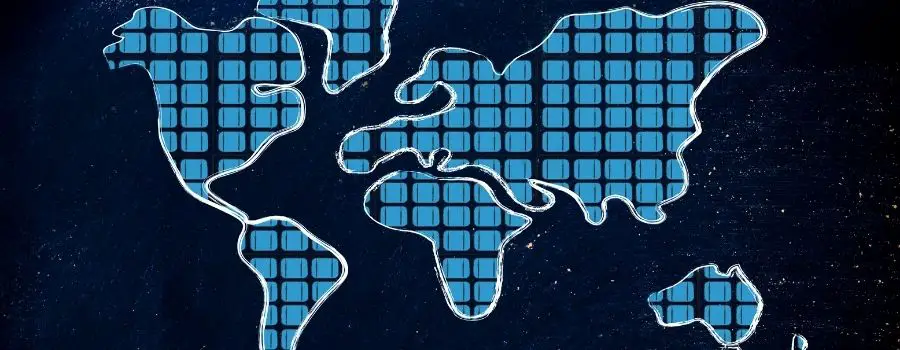Many of us have wondered why we can’t load up a desert with thousands of solar panels and then transport all of that energy to cities around the world. Swaths of Arizona and New Mexico could power the West Coast, the Sahara could power Northern Africa or Southern Europe. Since it hasn’t happened yet…it begs the question, can solar energy be transported?
While it is possible to transport solar power from one location to another, doing so would have prohibitive expenses and losses in electricity due to resistance from the length of conduit needed. To counter this, engineers would have the difficult task of raising the voltage to off-set resistance.

The amount of solar panels needed would also be astronomical since the ones in production today aren’t exceptionally efficient. Sure, they’re fine for powering homes and businesses…but entire cities at great distances, not yet.
Can Solar Energy Be Transported Wirelessly?
Theoretically, solar energy could be transported without wires by using a process called solar thermal power conversion. The sun’s rays would be converted into heat which would then turn water into steam. The steam would power a turbine which in turn creates electricity.
While it’s possible to convert solar energy into another form of energy that can be transported, it’s not currently being done on a large enough scale to power anything more than a small city.
The primary reason for this is that solar panels are only about 20% efficient at converting sunlight into electricity. This means that for every 100 units of sunlight that hits the solar panel, only 20 units are converted into usable energy.
It would take an enormous amount of solar panels to produce enough energy to power a city the size of Los Angeles or New York City and then transport that energy over long distances.
One solution scientists are working on is to find new ways to store electricity produced by solar and then transport it.
Can Solar Power Be Stored And Transported?
There are a few ways that solar power can be stored and then transported to other locations. Thermal storage, compressed air, liquid storage, and molecular solar thermal systems are a few being worked on today however, none can currently be transported at a large scale.
Some of these new storage systems for solar energy sound pretty fascinating…if not a little like science-fiction. Here are a few:
- Thermal Storage – This is the most common way solar energy is currently being stored. Solar thermal energy collectors heat up a fluid, which in turn powers a generator. This method is used mostly for commercial purposes.
- Compressed Air – Air can be heated with solar panels and then stored in a container at high pressure. When the air is released, it can power a turbine.
- Liquid Storage – Solar energy can be used to heat up a liquid, which is then stored in insulated tanks. The hot liquid can be used to generate electricity when needed.
- Molecular Solar Thermal System – This is a new solar storage method that uses solar energy to split water molecules into hydrogen and oxygen. The hydrogen can be used to power a fuel cell, while the oxygen can be released into the atmosphere.
Like I mentioned above, these all sound great but none can be stored and shipped in large enough quantities to make it work it. As new advances in solar panel technology and solar storage methods, it may only be a matter of time before solar power can be transported around the world.
Another, Non-Science Related Barrier: Government Instability
This is a bit off-topic, but it does relate to another reason that transporting solar energy from part of the globe to another…government instability.
As a whole, most countries do get along with each other…or at the very least tolerate each other. This is especially true of countries that produce fodder for the worlds energy needs (coal, oil, batteries, etc.) No one wants to upset the status quo and have another country’s citizens revolt, overthrow the government, and then refuse to sell them energy.
But we’ve seen it before back in 2014 when Russia annexed Crimea from Ukraine and we’re seeing again as Russia gobbles up more sections of Ukraine. One of the first things they did was cut off all natural gas supplies to Ukraine in an attempt to destabilize their government.
Desertec
An we’ve also seen it before with solar energy. Desertec, a company based in Germany, had the goal of providing solar power to Europe, the Middle East, and North Africa. But due to government instability in some of those countries (Libya, Egypt), the project was scrapped.
Their concept was to use high-voltage-direct-current-transmission (HVDC) and send it through cables to a mainland grid. They claim this would only have a 10% energy loss…which isn’t too bad.
As an alternative, they said they could use their plant in the Sahara to produce hydrogen (or similar) and transport it to various destinations.
Final Thoughts
Solar energy has the potential to be transported and stored in a number of ways, though none are currently feasible on a large scale. Scientists are constantly working on new solar cell materials and designs as well as storage methods, so it’s only a matter of time until this becomes a reality.
A non-science related barrier to solar transport is government instability in certain parts of the world. Desertec, a German solar company, had the goal of providing solar power to Europe, the Middle East, and North Africa but scrapped the project due to instability in some of those countries.
But, scientists and engineers continue to improve technology. As things develop and the tech gets cheaper, transporting solar energy all over the world can become a reality.

